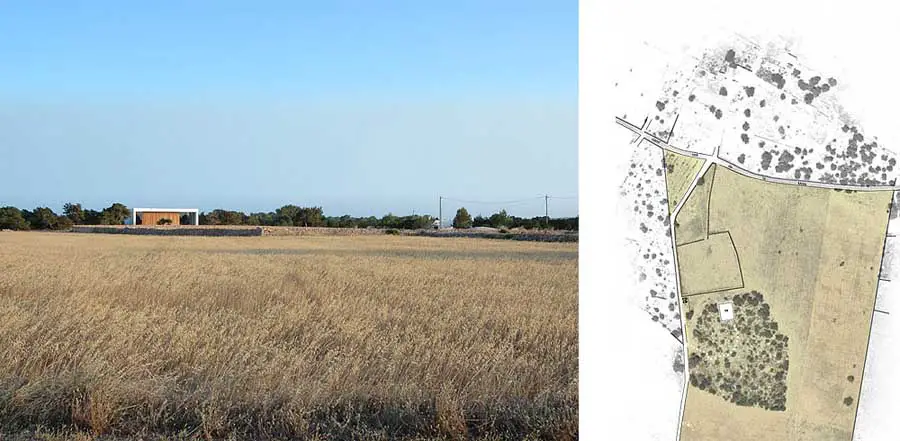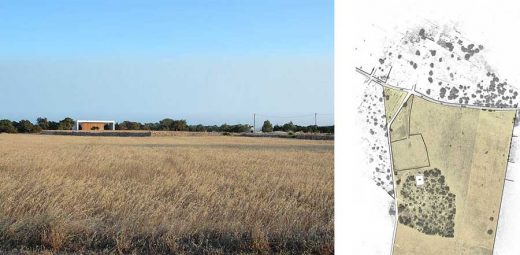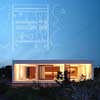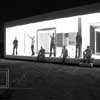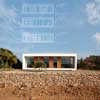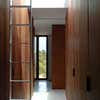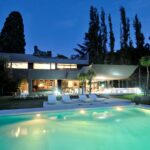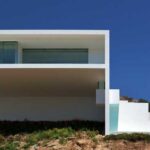Es Pujol de s’era Formentera Building Project, Photo, Spanish Restoration Design Images
Home / Office in Formentera
Es Pujol de s’era, Balearic Islands, Spain – design by Marià Castelló, architect
5 Mar 2010
Es Pujol de s’era
Location: Camí Vell de la Mola, Formentera, Illes balears, España
Date built: 2008
Design: marià castelló arquitecte
English text:
Home – Office in Formentera island
1. PLACE
Es Pujol de s’Era is a fairly representative fragment of the inland landscape of the island of Formentera. It comprises 33,022 square metres of wheat and barley fields, a small wood of common and Phoenician juniper and rosemary, and dry-stone walls on a practically flat topography.
The intervention seeks refuge among the existing vegetation and a fragment of dry-stone wall. These two conditions draw out the dimensions, the orientation and the height of a construction of austere geometry that bears some relation to the architectural tradition of Formentera.
A traditional dry-stone wall establishes the alignment in the territory and becomes part of the northern elevation of the building, at the same time setting it in the landscape. An old chapel built over an underground water cistern marks out the building’s longitudinal axis and is a constant reference of dialogue/tension, both in the exterior and the interior. This is an architecture that seeks context by means of relations with its surroundings, shunning mimesis.
2. PROGRAMME
The north-south orientation of the proposal generates a duality that was required by the programme and that the ground plan radi- cally synthesizes: segregation of the more public activity from private life. The north side is the most exposed; it is clearly visible from kilometre 2.3 on the Cami Vell de la Mola, the main approach route. On the north side there is a small architec- ture studio, repeated on the south side in the form of a space of identical dimensions, designed as a small dwelling-refuge for a couple. As well as seeking sunlight, the orienta- tion of the refuge responds to the desire to appropriate the small wood of common and Phoenician juniper and rosemary that extends like a native garden, requiring no transformation or maintenance, and gener- ates a high level of privacy. Between the studio and the dwelling is a nucleus of services that separates work from private life: bookshelves, files, bath- room, kitchen, beds, cupboards, installa- tions and two sliding walls to divide up the two main areas and create more intimate spaces, such as an annexed office or a guest room. This makes the house both flexible and multifunctional. The envelope containing the programme (12×12 m) extends in the two main direc- tions, generating spaces of transition that are vital in these latitudes.
3. MATTER
The volume is defined by an envelope of rendered thermo-clay masonry and reinforced concrete. An extruded section represents the only part where masonry is used on the site. The other interior and exterior facings were dry assembled, using glass and iroko timber. A small setback around the edge in section creates the sensation that the building is floating over the site. This is the transition between an artificial world and the pre- existing organic environment. The side openings are conceived as slashes that rend the facade from top to bottom, fragmenting the east and west elevations and giving them a smaller ‘grain’. With the idea of obtaining greater sobriety and harmony, the auxiliary elements and furnishings were specially designed, using the same materials employed for the dry-as- sembled elements of internal division.
Castellano text:
Estudio de Arquitectura + vivienda mínima en Formentera
1. LUGAR
Es Pujol de s’Era es un fragmento muy representativo del paisaje interior de la isla de Formentera. 33.022 m2 de campos de trigo y cebada, un pequeno bosque de savinas, romero y enebro, y muros de piedra seca sobre una topografia practicamente plana. La intervencion busca refugio entre la vegetacion existente y un fragmento de muro de piedra colocada en seco. Son estas dos directrices las que condicionan las dimensiones, la orientacion y la altura total de una edificacion de geometria austera que guarda paralelismos con la tradicion arquitectonica de Formentera. Un muro de piedra seca de factura tradicional establece las directrices de alineacion en el territorio y se convierte en parte del alzado norte del edificio, travandolo en el paisaje. Una vieja capilla de cisterna determina el eje longitudinal de la intervencion, siendo un referente objeto de dialogo-tension constante desde el exterior como desde el interior. Una arquitectura que busca la contextualidad a traves de las relaciones con el entorno, apartandose del mimetismo.
2. PROGRAMA
La orientacion Norte-Sur de la propuesta da lugar a una dualidad que el programa exigia y que la planta sintetiza radicalmente: segregar la actividad publica de la vida privada. La zona norte es la mas expuesta, se aprecia con claridad cuando se llega al kilometro 2,3 del Cami Vell de la Mola, que representa la via mas importante de acceso. En el extremo norte se encuentra un pequeno estudio de arquitectura, mientras que en el sur se ubica un espacio de identicas dimensiones concebido como una reducida vivienda-refugio para una pareja. A parte de buscar el asoleamiento, la orientacion del refugio responde a la voluntad de apropiarse del pequeno bosque se savinas, romero y enebro, que se concibe como un jardin autoctono, el cual no requiere ningun tipo de transformacion ni mantenimiento, y que genera un importante grado de intimidad-privacidad. Entre el estudio y la vivienda existe un nucleo de servicios que separa el trabajo de la vida privada, pero que a la vez los dota de infraestructuras: libreria, archivo, bano, cocina, camas, armarios, instalaciones y dos paredes correderas que permiten fragmentar las dos zonas principales, segregando espacios mas intimos como un despacho anexo o una habitacion de invitados. Se consigue asi una cierta flexibilidad y multifuncionalidad. La envolvente que contiene el programa (12x12m.) se prolonga en las dos orientaciones principales generando espacios de transicion entre el interior i el exterior, fundamentales en estas latitudes.
3. MATERIA
El volumen queda definido por una envolvente de fábrica de bloque de termoarcilla revestida y hormigón armado. Una sección extrusionada que representa la única parte de construcción húmeda de la obra. El resto de cerramientos interiores y exteriores se han ejecutado en seco, mediante cristal y madera de iroko. Un pequeño retranqueo perimetral en sección permite crear la sensación de que el edificio levita sobre el terreno en el que se emplaza. Es la transición entre un mundo artificial y las preexistencias de origen orgánico. Las aberturas laterales se han concebido como cortes que desgarran de arriba a abajo la fachada, fragmentando los alzados de levante y poniente, dotándolos de un “grano” más pequeño. Con el objetivo de lograr una mayor sobriedad y armonía, los elementos auxiliares y de mobiliario se han diseñado a propósito y se han escogido los mismos materiales que los utilizados en los elementos de compartimentación interior en seco.
Es Pujol de s’era Formentera – Building Information
Emplazamiento / location: Camí Vell de la Mola km. 2,3. Formentera
Promotor / promoter: Marià Castelló Martínez
Arquitecto / Architect: Marià Castelló Martínez
Arquitecto técnico / building engineer: Agustí Yern Ribas + Albert Yern Ribas
Estructura / structure: Albert Yern Ribas, José Antonio Molina, Salvador Soteras y Agustí Yern
Colaboradores / collaborators: Laura Tur, Carmen Martínez, Josep Castelló, Catalina Verdera, Jaume
Luís, Segundo García, Pep Yern y Belén Molina.
Constructor / builder: Construccions Pep Sala SL
Acabados/ finishes: Can Guirau Construcciones S.L.
Proyecto / project: 2004
Final de Obra / end of work: 2008
Superficie / surface: 201 m2
Fotografía / photography: Jaime Sicilia, Lourdes Grivé + Marià Castelló
Formentera house images / information from marià castelló arquitecte
Location: Formentera, Spain
Spanish Buildings
Contemporary Spanish Architectural Projects
Spanish Architectural Design – chronological list
Marià Castelló, arquitecte studio based in formentera, Illes balears (Baleraic Islands)
Spanish Architecture – Selection
Campus Palmas Altas
Rogers Stirk Harbour + Partners / Vidal y Asociados arquitectos
Campus Palmas Altas
Faustino Winery, Ribera del Duero
Foster + Partners
Spanish Winery
various interiors by famous architects
Spanish hotel building
Comments / photos for the Es Pujol de s’era Spanish Architecture page welcome
Es Pujol de s’era Formentera Building

